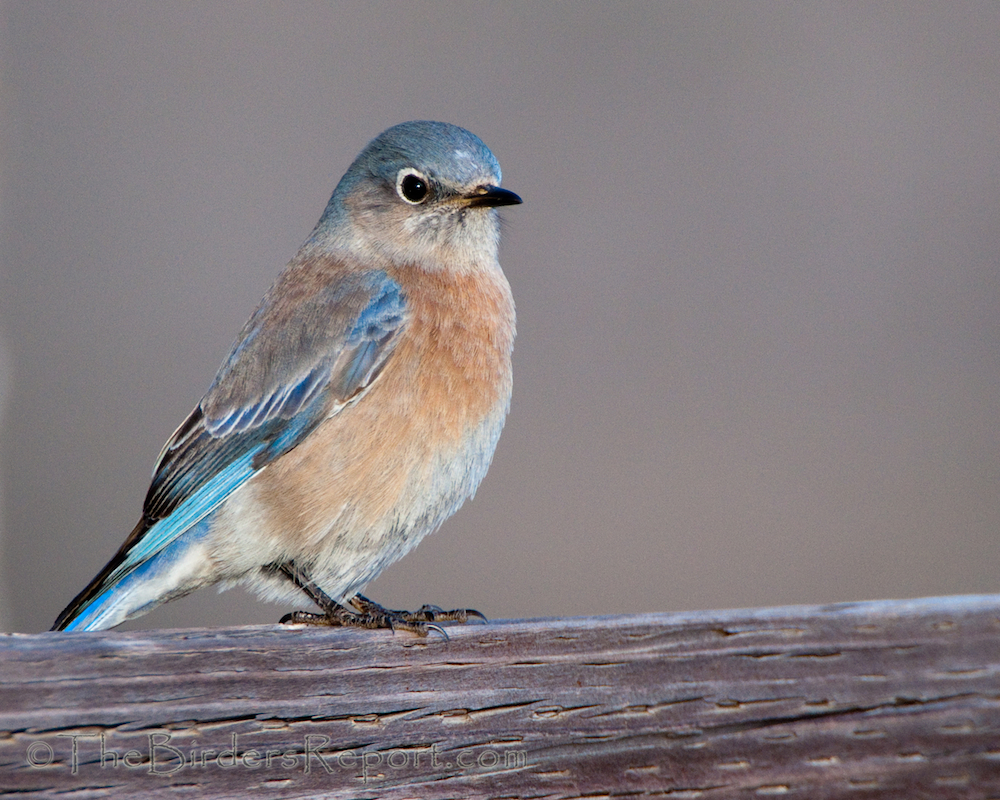
Join Education Chair Tricia Ford for a bird walk around Cascade Park on Thursday, November 10 at 9:00 am. This 27-acre park is located at the end of Girvan Road east of Highway 273 and borders the Sacramento River at the confluence of Olney Creek. The paved trail has several dirt paths, providing access to the river and the mouth of the creek. This will be the second in a series of eight walks, one per month from October through May, exploring bird watching in the parks and trails operated by the City of Redding. The theme of this walk will be the importance of mistletoe to birds of the oak woodland. The easy 1-mile walk will take about two hours. The park has restrooms and a drinking fountain. For more information, email triciathebirdnerd@gmail.com.
Tag Archives | western bluebird
The Gifts of the Oaks
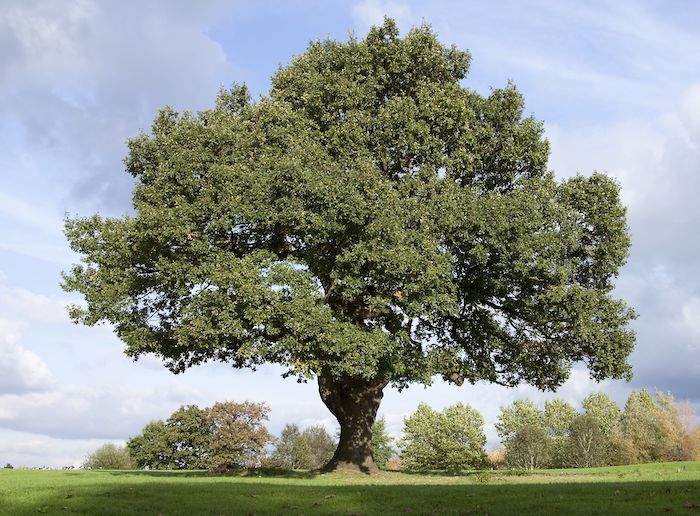
The earliest oak tree fossils, found in what is now the eastern US, are dated from twenty-five million years ago. Since then oaks have diversified around the globe, where they provide a wealth of food and shelter in support of a variety of rich, diverse ecosystems.
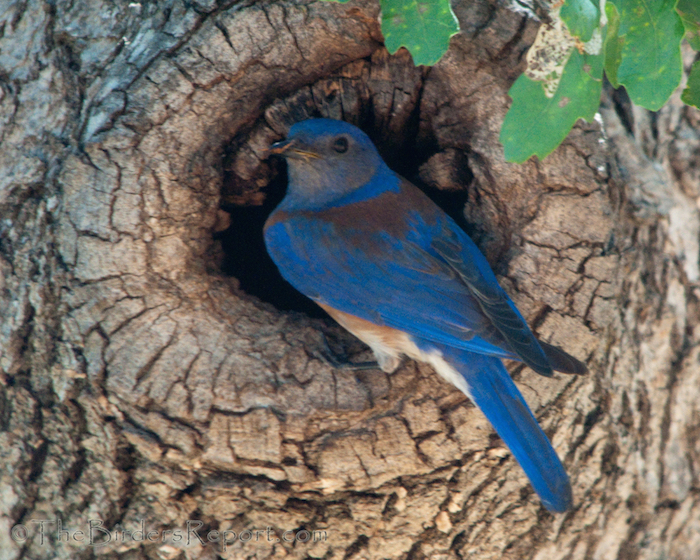
Western Bluebird Male
Several types of oaks make the North State home. Valley oaks deck our waterways with the majestic art of massive trunks and branches. Live oaks provide green foliage year round. Black oaks finger into conifers, painting our lower mountains with streaks and fields of autumn golds. But in the bathtub ring around the Central Valley, the foothills below the cooling mountain altitudes but above historic waterways, in the land of summer heat and drought, it is the blue oaks that dominate and define much of the landscape.
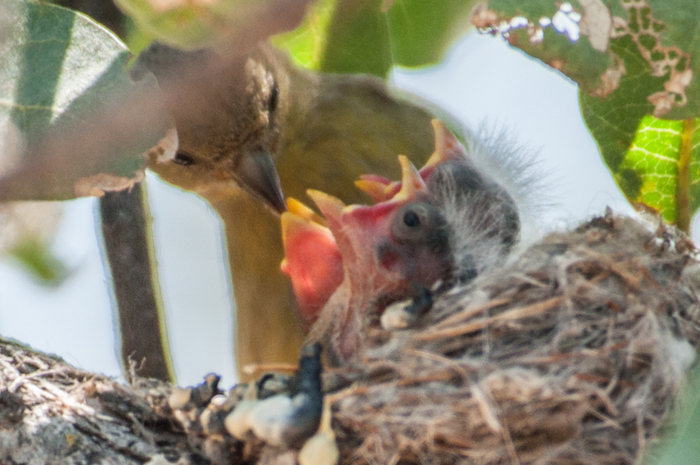
Female Lesser Goldfinch Feeding Nestlings
As one of the few trees that can populate this seasonally harsh environment, blue oaks are home to a vast variety of life forms. Their summer leaves, gone bluish and leathery to protect from water loss, are often studded with starbursts of galls, the nests of tiny wasps and flies. Studies on the blue oak’s Midwest cousins have shown as many as five hundred fifty-seven species of caterpillars on a single tree. As larvae and pupae these insects are life-sustaining for the birds that pick them from leaf and twig and trunk, variably to raise their young, fuel migration, and survive the winter–nuthatches, titmice, wrens, kinglets, warblers, vireos, and orioles. When the insects morph into adults with wings, they similarly feed flycatchers, hummingbirds, bluebirds, swallows, and waxwings.
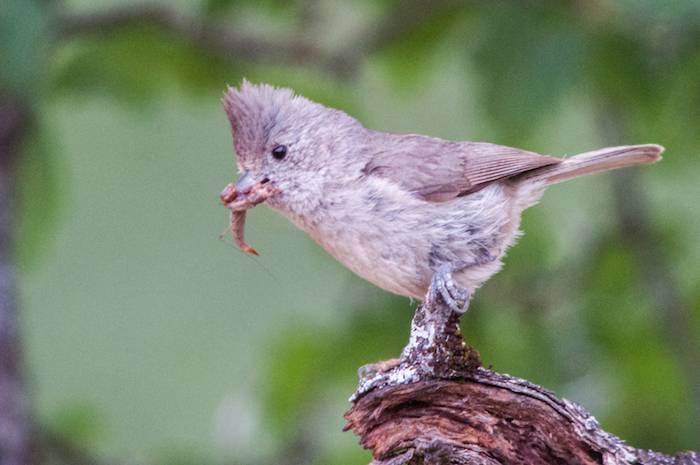
Oak Titmouse Approaches Nest with Insect for Nestlings
Downy woodpeckers join oak tree specialists–the theatrical acorn woodpeckers, beautiful Lewis’s woodpeckers, and trilling Nuttall’s woodpeckers–in picking beetle larvae, ants, and termites from the trees, and in making homes in the long-standing soft wood of dying oak branches–homes that are used for nesting by most of the birds already feeding on the oaks, plus a variety of owls and a falcon.
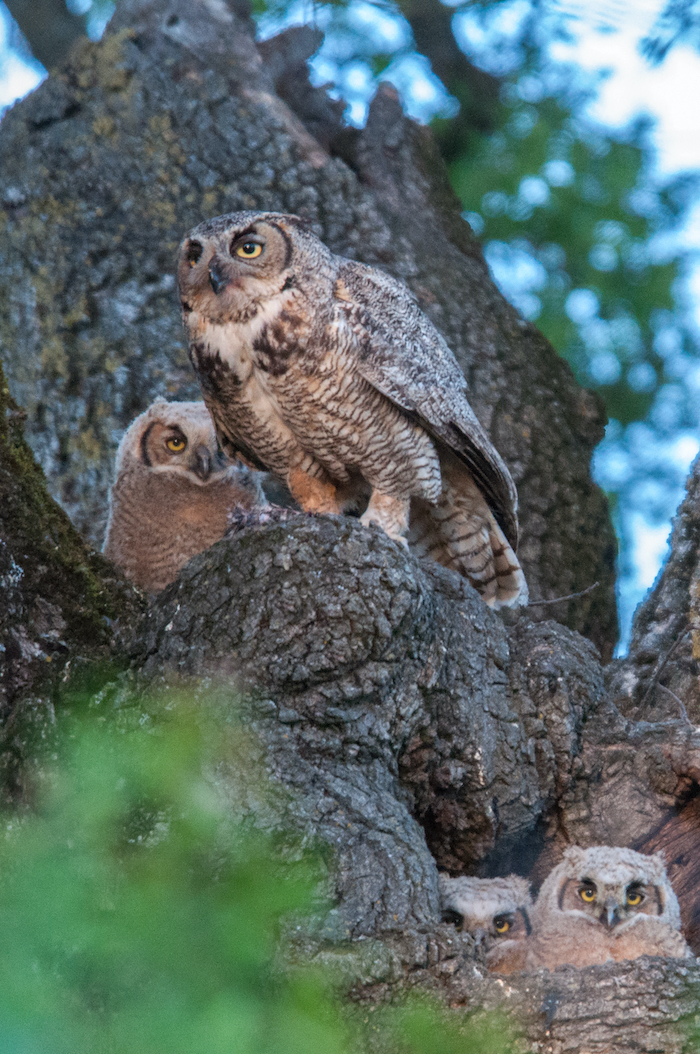
Great Horned Owl with Owlets Nesting in an Oak Tree
But none of this vitality even mentions the defining characteristic of oaks: acorns! Acorns are packed with proteins and fats and calories in general. Woodpeckers, band-tailed pigeons, scrub-jays, and turkeys are only some of their gourmands. Deer and bears feast on them. Gophers, mice, and ground squirrels chomp on fallen acorns, and in turn are eaten by bobcats, foxes, coyotes, and hawks. Yet more insects infest the acorns, and are eaten by reptiles, amphibians, and ground-feeding birds–sparrows, towhees, and quail.
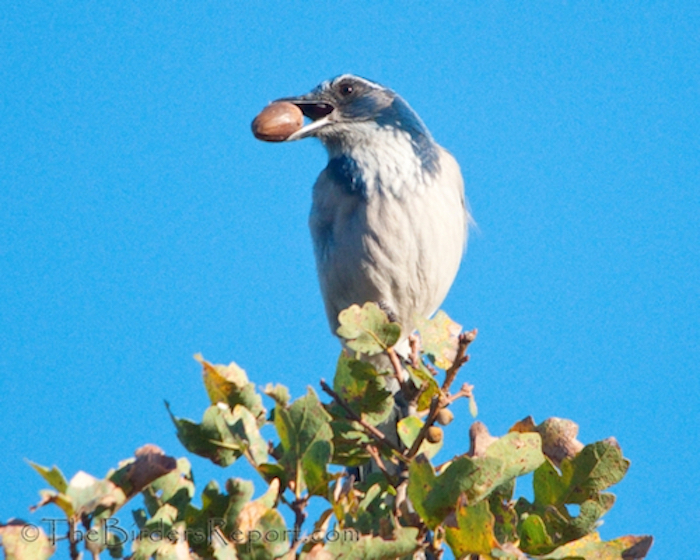
California Scrub-Jay Atop an Oak with an Acorn
Acorns are also devoured by cattle, who prefer grazing and resting near and under the oaks, and gain weight faster in oak-rich grasslands.
As a foundation for so much life, oaks truly are Giving Trees, and the blue oaks have a particularly special place for us in the North State.
Second Saturday Bird Walk on the Sacramento River Trail
While we have hosted many walks along the River Trail in the Turtle Bay area, this walk will encompass the northern section of the river trail. This will be an opportunity to observe the recovery of the riverine habitat that was burned during the 2018 Carr Fire and observe our winter bird population along this changed habitat. This area is also the area that Wintu Audubon has put up nesting boxes to support cavity nesting birds whose nesting sites were damaged during the fire. Depending on the group, the desire, and the weather, this walk can be up to a four mile loop. It is a great opportunity to see a beautiful resource for our community, and the wildlife that use it. Meet John Winchell at the parking lot at the South end of Diestelhorst Bridge at 8am for this walk along the River Trail.
Homes for Birds, Yard by Yard
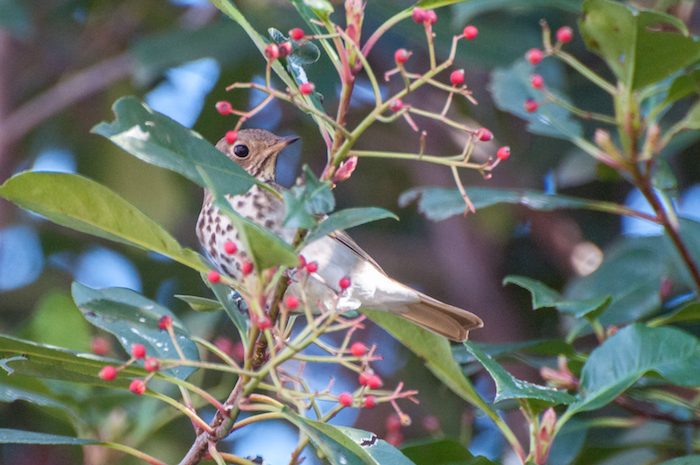
Hermit Thrush
For birds, yard after yard after yard adds up to a lot of potential homes. Backyard sanctuaries are pleasant for people, too, and fairly easy to provide. Just consider the basic elements of habitat: food, water, and shelter.
Providing food does not require filling feeders. Feeders can be fun because they draw birds for easy viewing, but they also require periodic cleaning to minimize spreading disease—say, once a month with a nine to one water to bleach solution. Hummingbird feeders require cleaning and refreshing every 2-3 days in the summer.
Plants will feed birds with less fuss. Berries and seeds on shrubs, grasses, and trees are all natural food supplies. Flowers, especially tubular ones like fuchsia and penstemon, offer nectar to hummingbirds. Benign neglect of gardens leaves old seedheads for winter consumption and unraked leaves for scratching through for the food they hold. Even without bird-edible fruits and seeds, plants feed insects, which become the main source of protein for songbirds around the world. Native plants are usually best, as they have evolved with the birds and insects of the area and usually support them most effectively.
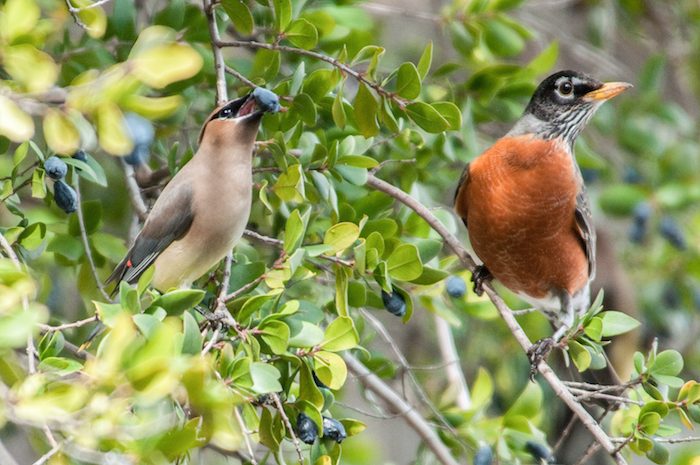
Cedar Waxwing and American Robin
Of course, avoid pesticides and herbicides. At worst they poison the birds, and at best they kill off the birds’ food source.
Plants also offer shelter. Some birds roost high in trees, others in shrubs, still others on the ground under brush. If décor and fire safety call for pruning up, consider retaining some low shrubbery for sparrows or quail. Woodpeckers carve numerous holes in dead wood, creating homes used by many bird species. You may choose not to leave whole snags standing, but just a standing trunk can invite excavations that bluebirds, wrens, flycatchers, titmice, nuthatches, and swallows will readily use.
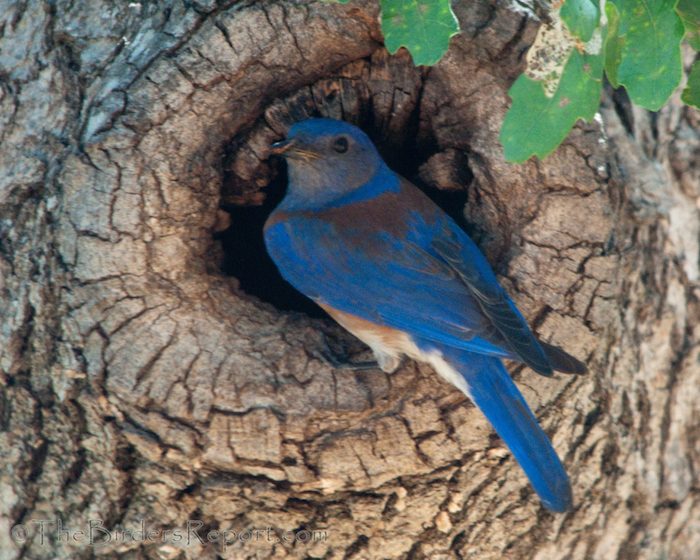
Western Bluebird Male
Those familiar cavity-nesters will also use home-made nesting boxes. To find bird-house directions, at wintuaudubon.org see Places to bird/Attracting birds. In our area, it’s best to mount your birdhouses in shaded areas.
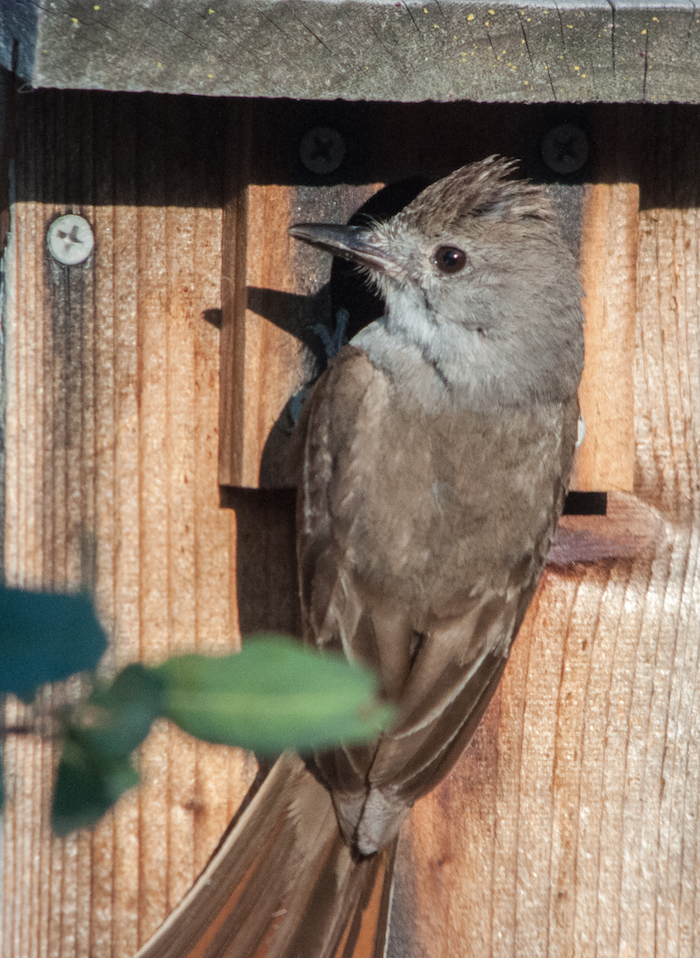
Ash-Throated Flycatcher
Of course, ensure that your yard is as feline-free as possible. Outdoor cats kill 15-20% of North American birds every year, including nearly 50% of suburban fledglings.
Water remains the elixir of life. A shallow pan, refreshed every day, makes an easy start. A trickle of running water invites many more visits. Small pumps are inexpensive and can run a home-made fountain if electricity is safely available. For permanent pools, mosquito-fish are available from Shasta County at (530) 365-3768.
Consider commercial fountains carefully. Songbirds prefer shallow puddles; a sloping edge will accommodate birds of different sizes for both drinking and bathing. Steep edges inhibit use.
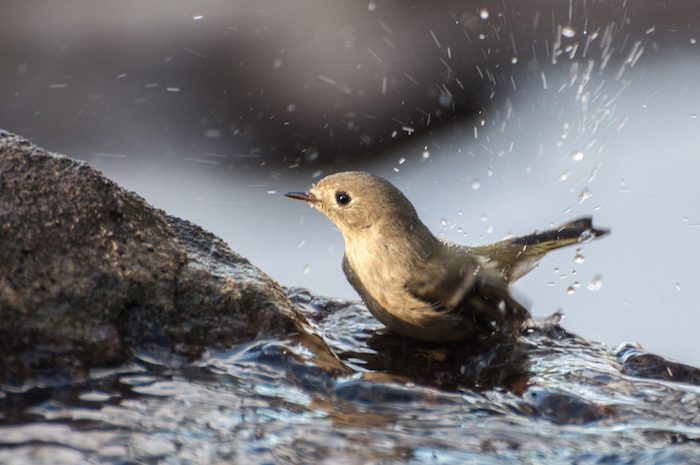
Ruby-crowned Kinglet
Birds have lost vast swathes of former habitat. The wildfires are hardly the worst of it. If we can curb the super-sizing of them, fires are natural, and the cycle of light burn and fresh regrowth benefits many species. The more devastating disruption is the permanent and widespread habitat conversion of historical oak woodlands, wildflower fields, and riparian meanders into row crops, monoculture orchards and tree farms, pavement, and buildings. Now climate change is expected to further eliminate half the seasonal range of 314 North American bird species. It’s a tough time to be dependent on an ecosystem.
We can shape our yards to offer the food, water, and shelter that will help many birds still find homes.
Second Saturday Bird Walk at Clover Creek Preserve
Clover Creek Preserve has a large, permanent pond with surrounding cattails and reed marsh, shallow winter pools and uplands planted to oaks. Plan to see shorebirds as well as species rare to urban areas such as Western Meadowlark, Western Bluebird, and Say’s Phoebe. The Great-tailed Grackle has expanded its range northward to include Shasta County and inhabits the cattail marsh. Meet your trip leader at the preserve near the south end of Shasta View Drive for this ½-day trip.
